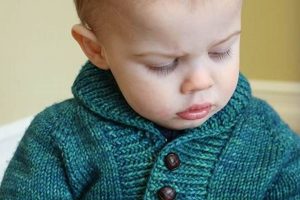Garments designed for infants and young male children, intended primarily for sleep and relaxation, typically feature a one-piece construction. These articles of clothing frequently incorporate features such as enclosed feet, snap or zipper closures for ease of dressing, and are often made from soft, breathable materials like cotton or fleece.
The use of these items provides several advantages, including warmth, comfort, and security for the child. They simplify nighttime dressing routines, reduce the need for separate blankets that can pose a safety hazard, and contribute to a consistent sleep environment. Historically, similar garments have been used for infants to ensure warmth and prevent nighttime awakenings due to discomfort.
The following sections will delve into the various materials utilized in their construction, detailing considerations for seasonal appropriateness, safety features, and practical advice for selecting the optimal size and style for the growing child.
Guidance on Selecting Appropriate Sleepwear for Infant Boys
The selection of appropriate sleepwear for infant boys requires careful consideration of several factors to ensure safety, comfort, and optimal sleep quality. This section outlines key guidelines to assist in making informed choices.
Tip 1: Prioritize Natural Fabrics. Opt for materials such as 100% cotton, muslin, or bamboo. These fabrics are breathable and minimize the risk of overheating, a critical factor in Sudden Infant Death Syndrome (SIDS) prevention. Synthetics may trap heat and moisture, leading to discomfort.
Tip 2: Consider Seasonal Appropriateness. Adjust the fabric weight based on the ambient temperature. Lightweight cotton is suitable for warmer months, while fleece or heavier cotton blends are preferable during colder periods. Avoid overdressing, which can lead to overheating.
Tip 3: Evaluate Closure Mechanisms. Examine the closures for security and ease of use. Snaps should be securely fastened and nickel-free to prevent allergic reactions. Zippers should have a fabric guard to prevent skin pinching. Avoid sleepwear with loose ribbons or ties that could pose a strangulation hazard.
Tip 4: Ensure Proper Sizing. Choose sleepwear that fits snugly but allows for freedom of movement. Avoid excessively loose or oversized garments, which can bunch up and restrict movement or become a hazard. Consult size charts provided by the manufacturer, considering the child’s weight and length.
Tip 5: Check for Flame Resistance. While flame-resistant chemicals are often added to synthetic fabrics, prioritize natural, untreated fabrics when possible. If choosing flame-resistant options, verify compliance with safety standards such as those set by the Consumer Product Safety Commission (CPSC).
Tip 6: Inspect for Loose Embellishments. Thoroughly inspect for loose buttons, appliques, or other embellishments that could detach and become a choking hazard. Remove or secure any such items before allowing the child to wear the garment.
Tip 7: Monitor Comfort Levels. Observe the child’s behavior while wearing the sleepwear. Signs of discomfort, such as excessive fussiness or skin irritation, may indicate an unsuitable material or fit. Adjust the layering as needed to maintain a comfortable body temperature.
Adhering to these guidelines promotes infant well-being by ensuring a safe and comfortable sleep environment. Prioritizing natural fabrics, appropriate sizing, and secure closures are fundamental aspects of selecting suitable sleepwear.
The subsequent section will explore the diverse styles and functionalities available, further aiding in the selection process.
1. Fabric Breathability
Fabric breathability, concerning garments designed for infant male children intended for sleep, directly influences thermal regulation and comfort. The permeability of the fabric dictates the rate at which air and moisture vapor pass through the material, impacting the microclimate surrounding the infant’s skin. Inadequate breathability leads to the accumulation of heat and perspiration, potentially causing discomfort, skin irritation, and increasing the risk of overheating. Overheating is a recognized risk factor in Sudden Infant Death Syndrome (SIDS). For instance, a sleeper constructed from tightly woven synthetic material, as opposed to loosely woven cotton, will exhibit reduced breathability, trapping heat and moisture against the infant’s skin. This direct causal relationship underscores the critical importance of fabric selection.
The selection of breathable materials in the construction of infant sleepwear mitigates the risks associated with thermal dysregulation. Natural fibers, such as cotton, bamboo, and merino wool, inherently possess greater breathability compared to synthetic alternatives like polyester or nylon. The structure of these natural fibers allows for air circulation and moisture absorption, promoting evaporation and maintaining a stable body temperature. Practically, this translates to a reduced likelihood of the infant experiencing discomfort or overheating during sleep, thereby contributing to a more restful and safer sleep environment. Furthermore, breathable fabrics are less likely to harbor moisture, reducing the potential for bacterial growth and skin irritation, thereby promoting overall skin health.
In summary, fabric breathability represents a fundamental component in the design and selection of appropriate sleepwear for infant boys. The direct correlation between breathability and thermal regulation necessitates prioritizing materials that facilitate air circulation and moisture wicking. Challenges remain in educating caregivers on the importance of fabric composition and in ensuring that manufacturers adhere to standards that prioritize infant safety. Ultimately, an understanding of fabric breathability and its impact on infant well-being contributes to the creation of safer and more comfortable sleep environments.
2. Closure Security
Closure security, with regard to sleepwear designed for infant boys, constitutes a critical safety parameter impacting both comfort and well-being. The primary function of closures, such as snaps, zippers, or ties, is to maintain the garment’s integrity throughout the sleep period, preventing unintended exposure or entanglement. A failure in closure security can lead to several adverse outcomes. For instance, dislodged snaps may present a choking hazard, while a malfunctioning zipper could expose the infant to cold or result in skin irritation. The secure fastening of these elements is therefore paramount. Real-world instances of infants becoming entangled in loose or detached closures highlight the practical significance of rigorous design and manufacturing standards. The inherent vulnerability of infants necessitates proactive measures to mitigate these potential risks.
Furthermore, the type of closure employed directly influences the ease of dressing and diaper changes, thereby affecting caregiver convenience and infant comfort. Strategically positioned and securely fastened closures minimize the duration of exposure during these procedures, reducing the risk of discomfort or agitation. Zippers, when properly shielded with fabric guards, offer a streamlined closure mechanism, while snaps provide a secure alternative, particularly when reinforced with robust stitching. The selection of appropriate closure types and their secure integration into the garment design are thus intertwined with practical functionality and safety considerations. Manufacturers bear the responsibility of ensuring that closures meet stringent safety requirements, including pull-force testing and material composition assessments.
In conclusion, closure security represents a non-negotiable aspect of sleepwear designed for infant boys. Its impact extends beyond mere garment functionality, encompassing critical safety considerations related to choking hazards, thermal regulation, and overall infant well-being. The challenges lie in maintaining consistent manufacturing standards and educating caregivers on proper inspection and maintenance of closures. Continued vigilance and adherence to established safety protocols are essential to ensuring the secure and comfortable sleep environment for infants.
3. Size Appropriateness
Size appropriateness, concerning sleepwear for infant boys, directly correlates with safety, comfort, and developmental milestones. A garment that is too large presents entanglement hazards, increasing the risk of suffocation or restricted movement. Conversely, sleepwear that is too small restricts circulation, inhibits free movement, and can cause skin irritation or discomfort, disrupting sleep patterns. The causal relationship is evident: inappropriate sizing directly influences the infant’s physical safety and physiological well-being. For instance, a sleeper that is several sizes too large could bunch up around the infant’s face, obstructing breathing. Size appropriateness is, therefore, not merely a matter of aesthetics but a fundamental safety component.
Accurate sizing promotes unrestricted physical development and exploration during waking hours, while simultaneously ensuring a safe and comfortable sleep environment. Properly fitted sleepwear allows for freedom of movement, supporting the infant’s natural development of motor skills. Garments that conform closely to the infant’s dimensions, without constricting, are essential. Practical application of this understanding involves meticulous attention to manufacturer size charts, regular measurements of the infant’s length and weight, and careful consideration of the fabric’s stretch and shrinkage properties. Furthermore, frequent assessment of the garment’s fit is crucial, as infants experience rapid growth, necessitating periodic adjustments in size.
In conclusion, the selection of correctly sized sleepwear for infant boys extends beyond convenience, serving as a critical component of infant safety and development. Challenges persist in ensuring consistent sizing standards across manufacturers and in educating caregivers about the importance of precise measurements and regular assessments. Ultimately, prioritizing size appropriateness contributes to a safer, more comfortable, and developmentally supportive environment for infants.
4. Seasonal Weight
Seasonal weight, in the context of infant sleepwear, directly impacts thermoregulation, influencing comfort and safety. Garment weight corresponds to fabric density and insulation capacity, with variations dictated by ambient temperature. The objective is to maintain a stable core temperature, mitigating the risk of overheating in warmer periods and preventing hypothermia in colder ones. The consequence of inappropriate seasonal weight manifests as discomfort, disrupted sleep, and potential physiological stress on the infant. A fleece sleeper during summer, for example, would significantly elevate body temperature, leading to agitation and potential heat rash. Conversely, a lightweight cotton sleeper in winter would inadequately insulate, resulting in discomfort and increased energy expenditure to maintain body heat.
Practical application of seasonal weight considerations involves selecting fabrics appropriate for the prevailing climate. Lightweight, breathable materials like muslin or cotton are suited for warmer seasons, facilitating air circulation and moisture evaporation. In contrast, heavier materials like fleece, knit cotton, or wool blends provide insulation during colder months. The use of layered clothing offers a flexible approach, enabling caregivers to adjust insulation levels as needed. Guidelines from pediatricians and child safety organizations advocate for dressing infants appropriately for the room temperature, rather than over-bundling, reinforcing the importance of seasonal weight considerations in maintaining a safe sleep environment.
In summary, seasonal weight is a crucial determinant in selecting safe and comfortable sleepwear for infant boys. The relationship between garment weight and thermoregulation necessitates careful selection of appropriate materials based on the prevailing climate. Challenges persist in educating caregivers regarding the nuances of infant thermoregulation and the potential dangers of overdressing or underdressing. Prioritizing seasonal weight considerations, informed by reliable guidelines, promotes a safe and restful sleep environment, thereby supporting infant well-being.
5. Safety Standards
Safety standards, applied to garments designed for infant boys intended for sleep, establish minimum requirements to mitigate potential hazards and ensure well-being. The causal relationship between adherence to these standards and infant safety is direct: compliance reduces the incidence of injuries and fatalities associated with unsafe sleepwear. These standards address factors such as flammability, small parts, lead content, and closure security. For example, flammability standards, such as those mandated by the Consumer Product Safety Commission (CPSC), aim to reduce the risk of burn injuries by requiring that sleepwear either be flame-resistant or fit snugly to prevent easy ignition. Real-life instances of severe burn injuries resulting from non-compliant sleepwear underscore the practical significance of these regulations. The presence of small parts, such as buttons or decorative embellishments, presents a choking hazard; therefore, standards dictate acceptable sizes and secure attachment methods.
Further examples of safety standards impacting design include limits on lead content in dyes and materials, which prevent potential neurological damage from exposure. Closure security standards mandate that snaps and zippers withstand a minimum force, preventing detachment and potential choking hazards or entanglement. Practical application of these standards involves rigorous testing by manufacturers, certification by independent laboratories, and ongoing market surveillance by regulatory agencies. These processes ensure that sleepwear offered for sale meets established safety criteria. Caregivers should seek out products labeled as compliant with relevant safety standards, providing an additional layer of assurance.
In summary, safety standards represent a critical component in the design and manufacture of sleepwear for infant boys. Adherence to these standards directly contributes to a reduction in preventable injuries and fatalities. Challenges persist in ensuring consistent enforcement of standards globally and in educating caregivers about the importance of selecting compliant products. Prioritizing sleepwear that meets or exceeds established safety requirements is essential for promoting infant safety and well-being.
Frequently Asked Questions
The following section addresses common inquiries concerning sleepwear designed for infant boys, providing evidence-based information to support informed decision-making.
Question 1: At what age is sleepwear with loose blankets considered safe for infant boys?
Sleepwear incorporating loose blankets is not recommended for infant boys under twelve months of age. The risk of suffocation and entanglement is elevated in younger infants due to limited mobility and coordination. Swaddling or fitted sleep sacks are safer alternatives until the infant demonstrates the ability to roll over independently.
Question 2: What constitutes a ‘breathable’ fabric for infant sleepwear, and why is it essential?
Breathable fabrics, such as 100% cotton, muslin, or bamboo, allow for air circulation and moisture wicking, mitigating the risk of overheating. Overheating is a recognized risk factor in Sudden Infant Death Syndrome (SIDS). Synthetic fabrics often lack adequate breathability, trapping heat against the infant’s skin.
Question 3: How frequently should sleepwear be washed, and what type of detergent is recommended?
Sleepwear should be washed before initial use and subsequently after each use or when visibly soiled. A fragrance-free, hypoallergenic detergent is recommended to minimize the risk of skin irritation. Double rinsing is advisable to remove detergent residue.
Question 4: What safety features should be prioritized when selecting sleepwear with zippers?
Sleepwear with zippers should incorporate a fabric guard to prevent skin pinching. The zipper pull should be securely attached and free of small, detachable parts. Avoid zippers that exhibit signs of damage or malfunction.
Question 5: What are the potential risks associated with sleepwear that is excessively large or small?
Overly large sleepwear poses a risk of entanglement or suffocation, while excessively small sleepwear can restrict circulation and inhibit movement. Properly fitted sleepwear allows for freedom of movement without posing a safety hazard.
Question 6: Are flame-resistant chemicals in sleepwear necessary for infant safety?
While flame-resistant sleepwear is mandated by certain regulations, it is possible to prioritize natural, untreated fabrics that fit snugly, thereby minimizing the risk of ignition and eliminating the need for chemical treatments. Caregivers should weigh the benefits and risks when selecting sleepwear options.
These responses emphasize the importance of fabric selection, appropriate sizing, and adherence to safety guidelines in mitigating potential risks associated with infant sleepwear.
The following sections will delve into style variation and market options, further assisting in informed purchasing decisions.
Concluding Remarks on Infant Male Sleepwear
This exploration of “baby boy sleepers” has underscored critical aspects related to safety, comfort, and developmental considerations. Fabric selection, closure security, appropriate sizing, seasonal weight, and adherence to safety standards are paramount in ensuring infant well-being. Addressing common inquiries through evidence-based responses facilitates informed decision-making, ultimately contributing to a safer and more comfortable sleep environment for infant males.
Continued vigilance regarding evolving safety guidelines, coupled with proactive education for caregivers, is essential. The selection of infant sleepwear constitutes a fundamental aspect of responsible caregiving, impacting both immediate comfort and long-term developmental outcomes. A commitment to prioritizing safety and informed purchasing decisions remains crucial in safeguarding the well-being of infants.







